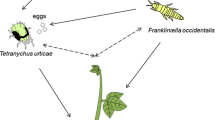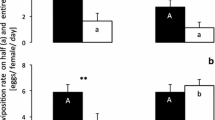Abstract
Little has been done to compare the relative importance of various mechanisms through which prey assess the potential risk from natural enemies. We used predator-naive spider mites (Tetranychus urticae, Tetranychidae) to (1) compare the responses of prey to chemical cues from enemy and non-enemy species and (2) investigate the source of these cues. In the laboratory, we observed the distribution of T. urticae in response to cues from nine mite species, including (1) predators of spider mites, (2) predators/parasites of other animals, and (3) fungivores/pollen-feeders. When given a choice over 24 h, spider mites foraged and oviposited in fewer numbers on leaf discs that were previously exposed to predatory or parasitic mites (including species incapable of attacking spider mites) than on clean leaf discs (unexposed to mites). Interestingly, previous exposure of leaf arenas to fungivores and pollen-feeders had no significant effect on spider mite distribution. We then observed the response of T. urticae to cues from two species of predator that had been reared on a diet of either spider mites or pollen. T. urticae showed stronger avoidance of leaf discs that were previously exposed to spider-mite-fed predators than of discs exposed to pollen-fed predators. Nevertheless, for one predator species (Amblyseius andersoni), T. urticae still preferred to forage and oviposit on clean (unexposed) discs than on discs exposed to pollen-fed predators. Protein-derived metabolic wastes of predatory or parasitic mites may provide a general cue about potential predation risk for T. urticae. However, T. urticae also avoided areas exposed to pollen-fed predators, suggesting there may be other sources of enemy recognition by the spider mites. We discuss the ecological and evolutionary mechanisms that may influence the scope of information through which animals assess predation risk.
Similar content being viewed by others
Author information
Authors and Affiliations
Additional information
Received: 11 January 1999 / Received in revised form: 25 October 1999 / Accepted: 20 November 1999
Rights and permissions
About this article
Cite this article
Grostal, P., Dicke, M. Recognising one’s enemies: a functional approach to risk assessment by prey. Behav Ecol Sociobiol 47, 258–264 (2000). https://doi.org/10.1007/s002650050663
Issue Date:
DOI: https://doi.org/10.1007/s002650050663




